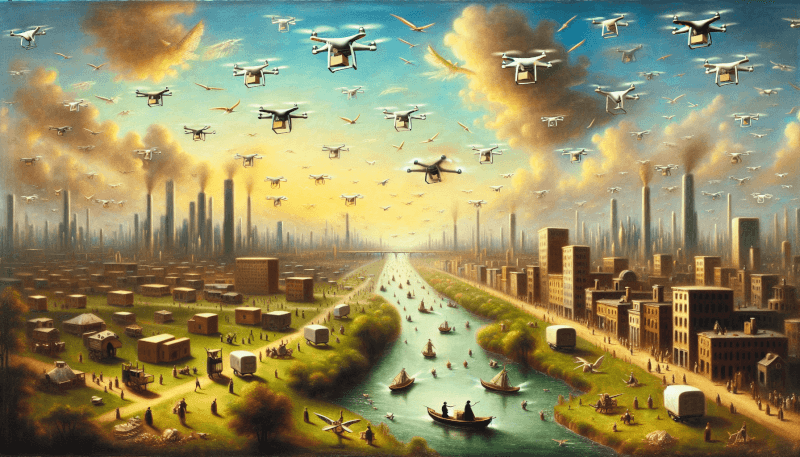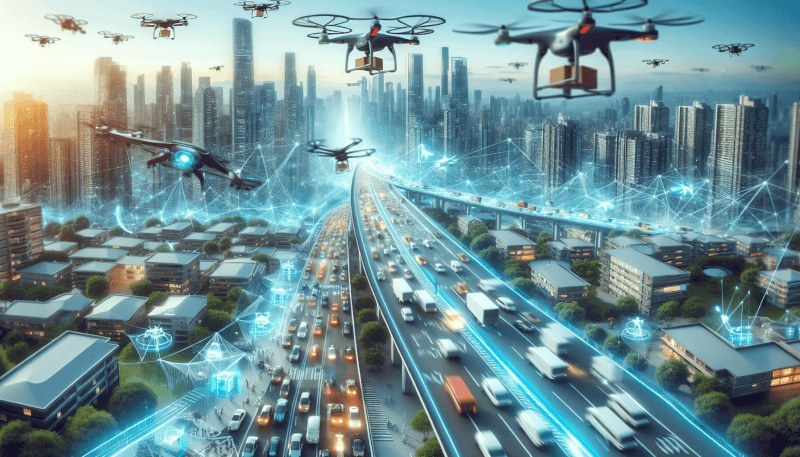Are you ready to embark on an exciting journey into the future of drone technology? In the next five years, the world of innovation and technological advancements in the field of drones is set to soar to new heights. From autonomous delivery drones revolutionizing the way we receive packages to cutting-edge drone swarm technology being deployed in search and rescue missions, there is no doubt that drones will play a pivotal role in shaping our future. So fasten your seatbelts and get ready to explore the endless possibilities that await us in the fascinating world of drone technology.
Advancements in Battery Technology
Increased Flight Time
One of the most significant advancements in drone technology in recent years has been the increase in flight time. Thanks to advancements in battery technology, drones can now stay airborne for longer periods, allowing for extended flight missions and more efficient use of resources. Longer flight times mean that drones can cover larger areas, gather more data, and perform more tasks before needing to return for a battery change or recharge.
Improved Charging Efficiency
Alongside increased flight time, there have also been improvements in charging efficiency for drone batteries. With faster charging speeds and better energy transfer capabilities, drones can spend less time charging and more time in the air. This is particularly beneficial for commercial applications where downtime can be expensive and productivity is crucial. Improved charging efficiency also promotes sustainability by reducing the overall energy consumption of drone operations.
Enhancements in Autonomous Navigation
Improved Collision Avoidance
Autonomous navigation is a key area of development in drone technology, and one of the major focuses has been on improving collision avoidance capabilities. Drones equipped with advanced sensors and intelligent algorithms can now better detect and avoid obstacles in real-time, ensuring safer and more reliable operations. This is especially important in crowded urban environments or during complex tasks where the risk of collisions is higher.
Better GPS Navigation
Accurate and reliable GPS navigation is essential for autonomous drones, and recent advancements have made significant strides in this area. Improved GPS technology allows drones to have precise positioning capabilities, enabling them to navigate accurately in various environments, including indoors and in challenging weather conditions. This enhances the overall safety and effectiveness of drone missions, whether it’s for aerial mapping, surveying, or search and rescue operations.

Integration with Artificial Intelligence
AI-powered Object Recognition
The integration of drones with artificial intelligence (AI) has revolutionized their capabilities in object recognition. AI-powered algorithms can now identify and classify objects, such as vehicles, buildings, and even specific individuals, with remarkable accuracy. This opens up numerous possibilities for applications like monitoring traffic patterns, conducting surveillance, or assisting in disaster response efforts. The ability to quickly and reliably recognize objects allows drones to gather valuable data and make informed decisions in real-time.
Automated Task Execution
Artificial intelligence also plays a crucial role in automating repetitive tasks that drones perform. Thanks to AI algorithms, drones can autonomously execute predefined flight patterns, follow specific routes, or even perform complex actions like precise crop spraying in agriculture. This automation not only saves time and effort but also greatly reduces the margin for error, ensuring consistent and reliable results. With AI-powered automated task execution, drones are becoming increasingly valuable tools across a wide range of industries.
Expansion of Commercial Applications
Delivery Services
One of the most prominent areas of growth for drone technology is in the field of delivery services. Companies like Amazon and DHL are actively exploring the use of drones to deliver packages quickly and efficiently. With improved battery technology, longer flight times, and autonomous navigation capabilities, drones can potentially revolutionize last-mile delivery by reaching remote locations and bypassing traffic congestion. The expansion of delivery services using drones has the potential to offer convenience, speed, and cost-effectiveness to businesses and consumers alike.
Agriculture and Farming
The agricultural industry has embraced drone technology for various applications, including crop monitoring, irrigation management, and plant health assessment. With advanced imaging capabilities and sensors, drones can quickly collect valuable data about soil conditions, plant growth, and potential crop diseases. This data enables farmers to make informed decisions, optimize resource allocation, and improve crop yields. Drones equipped with AI algorithms can even autonomously analyze the data and provide real-time recommendations to farmers.
Inspection and Maintenance
The use of drones for inspection and maintenance tasks is rapidly expanding across industries such as construction, energy, and infrastructure. Drones equipped with high-resolution cameras, thermal imaging, and LiDAR technology can perform detailed inspections of structures, pipelines, and power lines. This allows for early detection of potential issues, reduces the risk to human workers, and enables more efficient maintenance planning and asset management. Drones can access hard-to-reach areas safely and provide valuable visual and thermal data for analysis and decision-making.

Miniaturization and Improved Portability
Smaller and Lighter Drones
Advancements in materials and manufacturing techniques have led to the miniaturization of drone technology. Drones are now becoming smaller and lighter, making them more portable and easier to deploy. This is particularly beneficial for applications that require mobility, such as search and rescue operations or terrain mapping. Smaller drones are also less intrusive and can navigate through tight spaces with greater ease, expanding the range of environments where they can be utilized effectively.
Foldable and Compact Designs
Another aspect of improved portability is the development of foldable and compact drone designs. Folding drones allow for easy transportation and storage, making them ideal for professionals who need to travel with their equipment. These foldable designs do not compromise on performance or functionality and can quickly be unfolded and ready for flight. Compact drones, on the other hand, offer convenience and ease of use, making them accessible to a broader range of users, from hobbyists to professionals.
Increased Payload Capacity
Ability to Carry Heavier Loads
Advancements in drone technology have also led to an increase in payload capacity. Drones can now carry heavier loads, enabling the transportation of various equipment and supplies. This is particularly valuable for applications like aerial photography or cinematography, where the payload may include high-quality cameras or filming equipment. Increased payload capacity also opens up possibilities for delivery services to transport larger packages or even medical supplies in emergency situations.
Support for Specialized Equipment
In addition to carrying heavier loads, drones now have the ability to support specialized equipment for specific industries or applications. For example, drones equipped with thermal imaging cameras can be used for search and rescue missions to detect body heat or identify heat signatures in emergency situations. Similarly, drones with LiDAR technology can be utilized for 3D mapping, environmental analysis, or modeling. The ability to support specialized equipment makes drones versatile tools for a wide range of professional applications.

Advances in Imaging and Sensing Capabilities
High-Resolution Cameras
The imaging capabilities of drones have advanced significantly in recent years. Drones can now be equipped with high-resolution cameras that capture stunning aerial imagery and videos. These cameras offer greater clarity, sharpness, and color accuracy, allowing for detailed inspections, accurate surveying, and breathtaking aerial photography. High-resolution cameras also play a vital role in industries such as real estate, architecture, and environmental monitoring, providing valuable visual data for analysis and decision-making.
Thermal Imaging
Thermal imaging has become an essential sensing capability in drones, particularly for applications that require temperature measurements and analysis. Drones equipped with thermal cameras can detect heat signatures, identify thermal anomalies, and monitor temperature variations in real-time. This is particularly valuable in fields such as firefighting, industrial inspections, and wildlife monitoring. Thermal imaging allows for the identification of potential hazards, energy inefficiencies, or even the tracking of animals during nighttime operations.
LiDAR Technology
Light Detection and Ranging (LiDAR) technology has revolutionized the way drones can capture and analyze data. LiDAR sensors emit laser pulses and measure the time it takes for the pulses to return, creating highly accurate 3D models of the environment. This technology enables drones to capture detailed topographic data, assess terrain features, and even measure distances and volumes. LiDAR-equipped drones are invaluable in industries such as surveying, construction, and infrastructure planning, where precise measurements and modeling are essential.
Improved Communication and Connectivity
Longer Range Communication
Advancements in communication technology have greatly improved the range at which drones can transmit data and receive commands. Drones can now stay connected and communicate with ground control over longer distances, enabling operations that require extended range or remote control capabilities. This is particularly beneficial for applications such as pipeline inspections, search and rescue missions, or environmental monitoring in remote areas. Longer range communication enhances the overall reliability and effectiveness of drone operations.
Integration with 5G Technology
The integration of drones with 5G technology holds great promise for the future of drone connectivity. 5G networks offer significantly faster data transmission speeds, lower latency, and increased network capacity compared to previous generations. This opens up new possibilities for real-time data streaming, high-definition video transmission, and advanced drone control capabilities. With 5G integration, drones can operate more efficiently and reliably as they tap into the powerful capabilities of this next-generation communication technology.

Regulatory Framework and Airspace Integration
Standardization of Regulations
As drone technology continues to advance, regulatory frameworks are crucial to ensure safe and responsible drone operations. Governments and aviation authorities around the world are actively working to create standardized rules and regulations for drone usage. These regulations cover aspects such as flight restrictions, altitude limits, pilot certification, and privacy concerns. Standardization of regulations provides clarity for drone operators, promotes public safety, and encourages the integration of drones into existing airspace management systems.
Integration into Air Traffic Management Systems
The integration of drones into existing air traffic management systems is a key challenge in ensuring safe and efficient airspace operations. Efforts are being made to develop systems that allow drones to be detected, tracked, and monitored by air traffic control. This integration will enable seamless coordination between manned aircraft and drones, preventing possible collisions and ensuring the safe coexistence of both in shared airspace. Advanced technologies such as geo-fencing and real-time airspace monitoring are being explored to support the integration and management of drones within existing air traffic systems.
Rise of Drone Swarms
Coordinated Operations
The concept of drone swarms involves multiple drones working together in a coordinated manner to achieve a common goal. This emerging technology has the potential to revolutionize various industries such as search and rescue, surveillance, and entertainment. Coordinated drone swarms can perform tasks collectively that would be challenging or impossible for individual drones. By leveraging advanced communication and autonomous algorithms, drone swarms can accomplish complex missions, provide enhanced situational awareness, and even create impressive aerial displays.
Distributed Task Execution
Distributed task execution is a key feature of drone swarms. Instead of relying on a single drone to complete a task, swarm systems divide the workload among multiple drones. This approach not only improves efficiency but also enhances redundancy and fault tolerance. If one drone in the swarm encounters an issue or runs out of power, others can seamlessly take over the task, ensuring the mission’s overall success. This distributed task execution capability makes drone swarms resilient, adaptable, and well-suited for applications that require large-scale operations or continuous monitoring.
In conclusion, advancements in drone technology are driving significant progress in various areas, including battery technology, autonomous navigation, AI integration, commercial applications, miniaturization, payload capacity, imaging and sensing capabilities, communication and connectivity, regulatory frameworks, and the rise of drone swarms. These advancements are set to transform industries, revolutionize processes, and open new possibilities for both professional and recreational drone use in the next five years. As drones become more capable, reliable, and intelligent, their potential for enhancing efficiency, safety, and innovation continues to grow.



